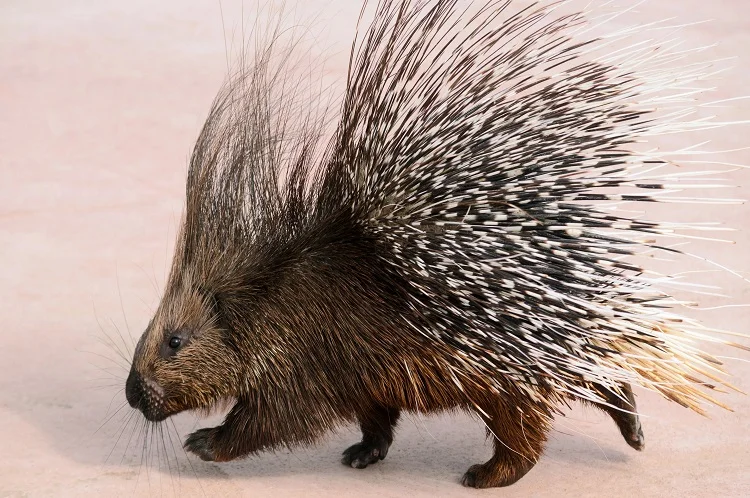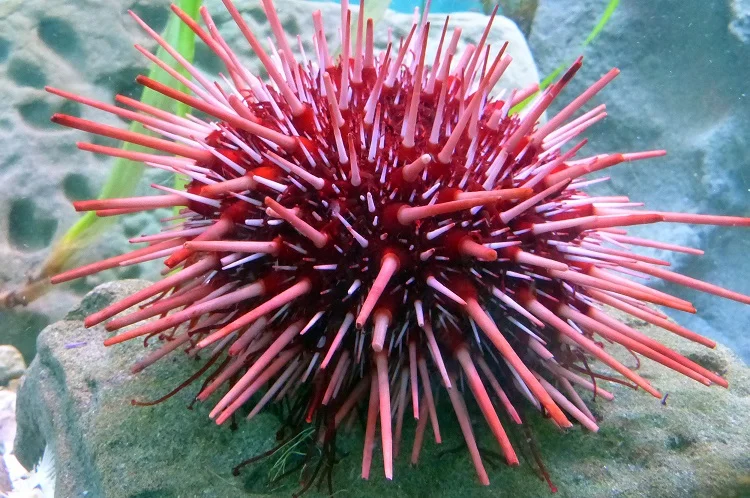There are fascinating biology features in the animal kingdom. Features like different blood colour, unique body parts, etc. are common. One of these special features is having spikes on the body.
There are many animals in the animal kingdom that have spikes on their body whether for defence or offence. These spikes on an animal body are mainly a defence mechanism that helps them from ferocious predators.
List of the animals with spikes on their body:
1. Hedgehogs

Scientific Name : Erinaceus europaeus
Spikes on : Back
Use : Defence
The spikes on Hedgehog’s body are a part of a defence mechanism. These spines are sharp and hollow.
They cover the back of Hedgehog providing them protection from predators. When they are threatened or feel any kind of danger, the Hedgehog rolls up into a ball.
For humans, the Hedgehog’s spikes are mostly harmless unless you are handling the in a rough manner.
2. Echidna

Scientific Name : Tachyglossus aculeatus
Spikes on : Back, Head and Tail
Use : Defence
These spikes are an Echidna’s defence mechanism when predators attack. These spikes are nothing but modified or specialised hairs.
Echidna’s back, head and tail are covered with these spikes. They are also known as Spiny Anteaters. Just like Hedgehog, Echidna also curl into a ball, pointing their spikes out to protect from attackers.
These spikes are not poisonous but they sure are sharp to keep the attackers away from them.
3. Tenrec

Scientific Name : Tenrec ecaudatus
Spikes on : Back, Sides and Tail
Use : Defence and Communication
Tenrecs are small mammals native to Madagascar. They also possess spikes as a defence mechanism. These spikes are modified hairs, which help in protecting them from predators or attackers.
But these spikes are not just for defence but also for communication. Tenrecs rub their quills together to produce ultrasonic sound. This process is known as stridulation. It is used to communicate between tenrecs in a group.
Just like Hedgehogs and Echidna, the Tenrec’s spikes are also not poisonous.
4. Porcupine

Scientific Name : Erethizon dorsatum
Spikes on : Back and Rump
Use : Defence and Signaling
Porcupines are known for their sharp, needle-like spines, called quills, that cover their backs, sides, and tails. These quills acta as a powerful defense that helps protect the porcupine from predators.
Unlike Echidnas, whose spikes are fixed on their body, Porcupine quills are loosely attached to their skin and can easily detach when an animal attacks or comes into contact with them. The quills have barbed ends, which makes them quite difficult to remove once they are embedded or stuck in an attacker.
Along with defence, porcupine quills are used for signaling purposes.
5. Spiny Rats

Scientific Name : Echimyidae
Spikes on : Back and Rump
Use : Defence
Spiny rats have spiny and bristle hairs.These hairs or furs can vary from well developed to stiff hairs in different types. These bristles help them in protecting against predators by making them harder to bite and catch.
When threatened, the spiny rats puff up their hair to appear as a large animal. The spiny rats aso use a shindig process called tail autotomy through which they shed their tails if caught and regenerate later. It allows them to escape from predators.
6. Armadillo Lizard

Scientific Name : Ouroborus cataphractus
Spikes on : Tail
Use : Defence
The Armadillo Lizard is native to the desert areas of South Africa. They have adapted their tails into a spiky tail. This helps protect them from predators.
When threatened or frightened, it takes his tail into his mouth and curls into a ball forming a ring of spikes with its tail. This makes it hard for the predators to swallow the armadillo lizard.
7. Sea Urchins

Scientific Name : Echinus esculentus
Spikes on : Entire Body
Use : Defence, Sensory and Locomotion
Sea urchins are marine animals that have spherical shape and spikes all over their body. These serve the purpose of a defence mechanism against predators. Along with defence, spikes also help in moving, allowing the move on the ocean floor. Sea urchins also use these spikes to sense light, chemicals and touch.
Unlike the most of the animals on our list, sea urchin’s spikes are venomous. They deliver painful stings that causes irritation, swelling, and other reactions depending on the species.
8. Pufferfish

Scientific Name : Tetraodontidae
Spikes on : Entire Body (Most Species)
Use : Defence
Pufferfish, also known as Blowfish, are aquatic animals. This name is given to this creature due to its ability to blow themselves with water or air) up to several times their size.
When a pufferfish is threatened, it blows itself and increases its size. Due to this, the prickly bumps on its body look intimidating to predators.
The spikes on the puffer fish’s body are not poisonous but they do possess a powerful toxin that can be lethal to predators including humans.
9. Thorny Devil

Scientific Name : Moloch horridus
Spikes on : Entire Body
Use : Defence, Drinking and Camouflage
The spikes on the thorny devil’s body serve various purposes like defence against predators, drinking water and also as a false head. Through the grooves between its spikes it collects water from dew or rain and then grooves channels the water to its mouth through capillary action.
The spikes on its body also get blended into the desert surroundings too, so that predators can’t easily spot them.

